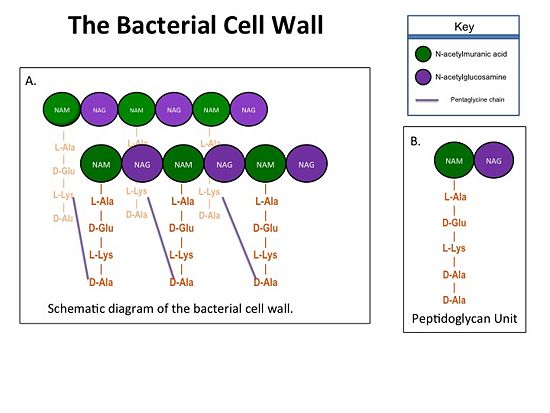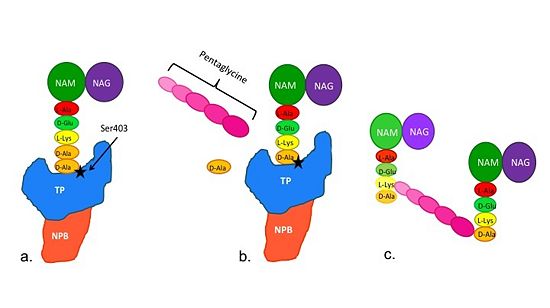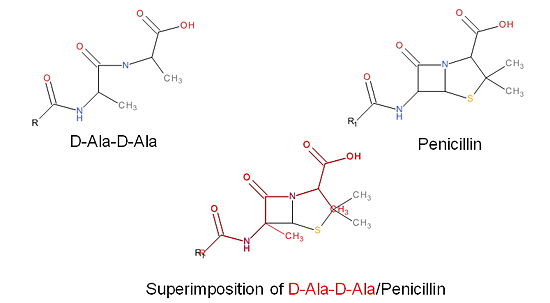Sandbox 126
From Proteopedia
(Difference between revisions)
| Line 1: | Line 1: | ||
<StructureSection load='4dki' size=500 side=right scene='37/372726/Pbp2a_with_residues/3'> | <StructureSection load='4dki' size=500 side=right scene='37/372726/Pbp2a_with_residues/3'> | ||
Transpeptidases (TP), also known as penicillin-binding proteins (PBP), catalyze the cross-linking of peptidoglycan polymers during bacterial cell wall synthesis. Beta-lactam (β-lactam) antibiotics, which include penicillins, cephalosporins and carbapenems, bind and irreversibly inhibit transpeptidases. The overuse and misuse of β-lactam antibiotics has led to strains of Staphylococcus aureus that are resistant to all β-lactams and are often only susceptible to “last resort antibiotics”, such as vancomycin. | Transpeptidases (TP), also known as penicillin-binding proteins (PBP), catalyze the cross-linking of peptidoglycan polymers during bacterial cell wall synthesis. Beta-lactam (β-lactam) antibiotics, which include penicillins, cephalosporins and carbapenems, bind and irreversibly inhibit transpeptidases. The overuse and misuse of β-lactam antibiotics has led to strains of Staphylococcus aureus that are resistant to all β-lactams and are often only susceptible to “last resort antibiotics”, such as vancomycin. | ||
| - | |||
| - | |||
== Cell Wall Structure == | == Cell Wall Structure == | ||
| Line 12: | Line 10: | ||
== Structure of a Resistant Transpeptidase == | == Structure of a Resistant Transpeptidase == | ||
| - | Methicillin resistant Staphylococcus aureus (MRSA) is resistant to all β-lactams because it acquires an alternative PBP, PBP2a, that is not bound or inhibited by any β-lactams. PBP2a is composed of two domains:<scene name='37/372726/Tp_and_npb_domain/3'>a non-penicillin binding (NPB) domain and a TP domain</scene> . The NBP domain of PBP2a is anchored in the cell membrane, while the TP domain “sits” in the periplasm with its active site facing the inner surface of the cell wall. The <scene name='37/372726/Close_up_of_active_site/8'>active site</scene> contains a serine residue at position | + | Methicillin resistant Staphylococcus aureus (MRSA) is resistant to all β-lactams because it acquires an alternative PBP, PBP2a, that is not bound or inhibited by any β-lactams. PBP2a is composed of two domains: <scene name='37/372726/Tp_and_npb_domain/3'>a non-penicillin binding (NPB) domain and a TP domain</scene>. The NBP domain of PBP2a is anchored in the cell membrane, while the TP domain “sits” in the periplasm with its active site facing the inner surface of the cell wall. The <scene name='37/372726/Close_up_of_active_site/8'>active site</scene> contains a serine residue at position <scene name='37/372726/Ser403_no_backbone/1'>403</scene> (Ser403), which catalyzes the cross-linking of the peptidoglycan rows with pentaglycine cross-links. |
| - | <scene name='37/372726/Ser403_no_backbone/1'>403</scene> (Ser403)which catalyzes the cross-linking of the peptidoglycan rows with pentaglycine cross-links. | + | |
| - | + | ||
| - | + | ||
== Catalytic Mechanism of PBP2a == | == Catalytic Mechanism of PBP2a == | ||
| Line 30: | Line 25: | ||
The entire process takes 4 milliseconds. | The entire process takes 4 milliseconds. | ||
| - | |||
| - | |||
== How do antibiotics work? == | == How do antibiotics work? == | ||
| Line 40: | Line 33: | ||
inhibited by the β-lactam. As a result, the synthesis of the cell wall is inhibited which leads | inhibited by the β-lactam. As a result, the synthesis of the cell wall is inhibited which leads | ||
to cell lysis. | to cell lysis. | ||
| - | |||
| - | Figure 2. Mechanism of action of β-lactams. (a) Structure of a β-lactam (penicillin) | ||
| - | showing the amide, carboxyl, and β-lactam ring groups. (b) Structure of the D-Ala- | ||
| - | D-Ala substrate. (c) Overlay of the D-Ala-D-Ala substrate in red with penicillin | ||
| - | demonstrating molecular mimicry. | ||
[[Image:Structures on penicillin and b lactam.jpg|thumb|alt= Alt text|Figure 3. Mechanism of action of β-lactams. A. Structure of a β-lactam (penicillin) showing the amide, carboxyl, and β-lactam ring groups β-lactam ring groups. B. Structure of the D-Ala-D-Ala substrate. C. Overlay of the D-Ala-D-Ala substrate in red with penicillin demonstrating molecular mimicry.|550 px]] | [[Image:Structures on penicillin and b lactam.jpg|thumb|alt= Alt text|Figure 3. Mechanism of action of β-lactams. A. Structure of a β-lactam (penicillin) showing the amide, carboxyl, and β-lactam ring groups β-lactam ring groups. B. Structure of the D-Ala-D-Ala substrate. C. Overlay of the D-Ala-D-Ala substrate in red with penicillin demonstrating molecular mimicry.|550 px]] | ||
| Line 57: | Line 45: | ||
<scene name='37/372726/Met641_and_tyr446/1'>Tyr446 and Met641</scene>. As a result of its <scene name='37/372726/Active_site_with_ceftobiprole/2'>tighter binding to PBP2a</scene>, ceftobiprole is able to more efficiently react with the serine active site residue and therefore inhibit the activity of PBP2a. | <scene name='37/372726/Met641_and_tyr446/1'>Tyr446 and Met641</scene>. As a result of its <scene name='37/372726/Active_site_with_ceftobiprole/2'>tighter binding to PBP2a</scene>, ceftobiprole is able to more efficiently react with the serine active site residue and therefore inhibit the activity of PBP2a. | ||
| - | Figure 5. Mechanism of action of ceftobiprole. (a) Structure of ceftobriprole. | + | Figure 5. Mechanism of action of ceftobiprole. (a) Structure of ceftobriprole. |
(b) The R2 group of ceftobiprole is bound by PBP2a, Tyr446, and Met641. This | (b) The R2 group of ceftobiprole is bound by PBP2a, Tyr446, and Met641. This | ||
increased binding allows the serine residue active site (Ser403) to hydrolyze the β- | increased binding allows the serine residue active site (Ser403) to hydrolyze the β- | ||
lactam ring and become irreversibly inhibited. (c) Schematic of β-lactam covalently | lactam ring and become irreversibly inhibited. (c) Schematic of β-lactam covalently | ||
bonded to active site blocking entrance to the substrate. | bonded to active site blocking entrance to the substrate. | ||
| - | |||
== PBP2a and Ceftaroline == | == PBP2a and Ceftaroline == | ||
| - | |||
<scene name='37/372726/3zfz_with_muramic_acid/1'>PBP2a in complex with Ceftaroline (3zfz)</scene> | <scene name='37/372726/3zfz_with_muramic_acid/1'>PBP2a in complex with Ceftaroline (3zfz)</scene> | ||
| - | In addition to TP domain of PBP2a, there is an allosteric domain in which the distance between the the active site and the allosteric site is 60Å. Allosteric site serves as a binding site for the substrate peptidoglycan. When the substrate binds to the <scene name='37/372726/3zfz_allosteric_site/1'>allosteric site</scene>, a conformational change occurs at the active site, opening it and allowing catalytic action to occur. The medicine,<scene name='37/372726/Ceftaroline/3'>Ceftaroline</scene>, <scene name='37/372726/3zfz_allosteric_site_and_ceft/1'>mimics the substrate at the allosteric site</scene> opening the active site, allowing ceftaroline to enter and bind noncovalently. | + | In addition to TP domain of PBP2a, there is an allosteric domain in which the distance between the the active site and the allosteric site is 60Å. Allosteric site serves as a binding site for the substrate peptidoglycan. When the substrate binds to the <scene name='37/372726/3zfz_allosteric_site/1'>allosteric site</scene>, a conformational change occurs at the active site, opening it and allowing catalytic action to occur. The medicine,<scene name='37/372726/Ceftaroline/3'>Ceftaroline</scene>, <scene name='37/372726/3zfz_allosteric_site_and_ceft/1'>mimics the substrate at the allosteric site</scene> opening the active site, allowing ceftaroline to enter and bind noncovalently. |
| - | + | ||
| - | + | ||
Revision as of 20:41, 5 May 2014
| |||||||||||



